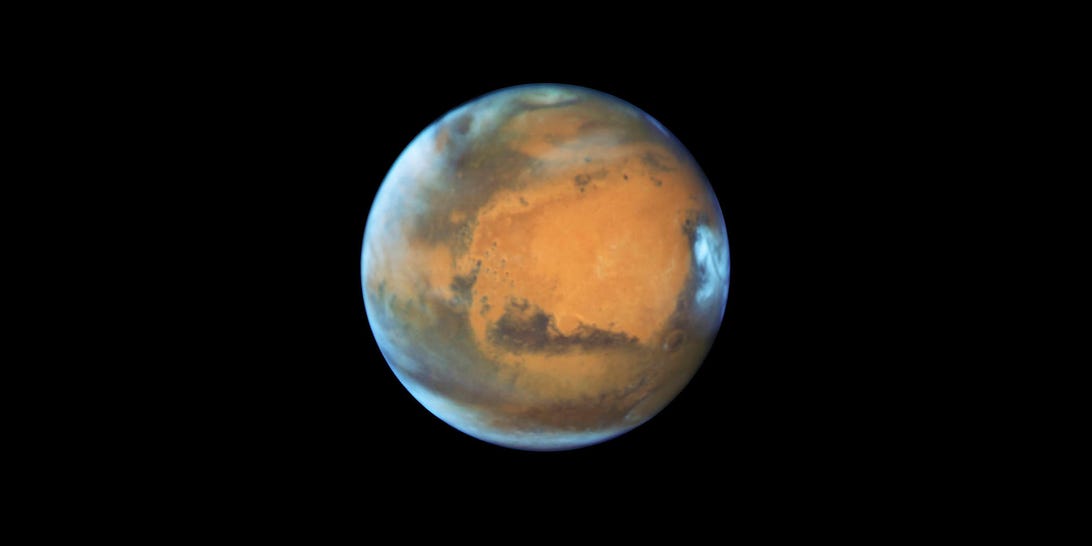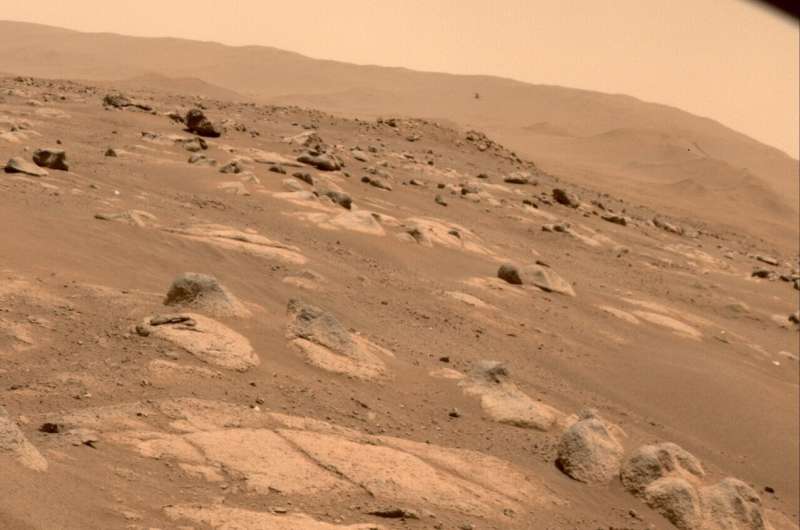A human space mission would be viable if it doesn't exceed four years, an international research team concludes in new research
Answering two key questions would go a long way toward overcoming that hurdle: Would particle radiation pose too grave a threat to human life throughout a round trip to the red planet? And, could the very timing of a mission to Mars help shield astronauts and the spacecraft from the radiation?
In a new article published in the peer-reviewed journal Space Weather, an international team of space scientists, including researchers from UCLA, answers those two questions with a "no" and a "yes."
That is, humans should be able to safely travel to and from Mars, provided that the spacecraft has sufficient shielding and the round trip is shorter than approximately four years. And the timing of a human mission to Mars would indeed make a difference: The scientists determined that the best time for a flight to leave Earth would be when solar activity is at its peak, known as the solar maximum.
The scientists' calculations demonstrate that it would be possible to shield a Mars-bound spacecraft from energetic particles from the sun because, during solar maximum, the most dangerous and energetic particles from distant galaxies are deflected by the enhanced solar activity.
A trip of that length would be conceivable. The average flight to Mars takes about nine months, so depending on the timing of launch and available fuel, it is plausible that a human mission could reach the planet and return to Earth in less than two years, according to Yuri Shprits, a UCLA research geophysicist and co-author of the paper.
"This study shows that while space radiation imposes strict limitations on how heavy the spacecraft can be and the time of launch, and it presents technological difficulties for human missions to Mars, such a mission is viable," said Shprits, who also is head of space physics and space weather at GFZ Research Centre for Geosciences in Potsdam, Germany.
The researchers recommend a mission not longer than four years because a longer journey would expose astronauts to a dangerously high amount of radiation during the round trip -- even assuming they went when it was relatively safer than at other times. They also report that the main danger to such a flight would be particles from outside of our solar system.
Shprits and colleagues from UCLA, MIT, Moscow's Skolkovo Institute of Science and Technology and GFZ Potsdam combined geophysical models of particle radiation for a solar cycle with models for how radiation would affect both human passengers -- including its varying effects on different bodily organs -- and a spacecraft. The modeling determined that having a spacecraft's shell built out of a relatively thick material could help protect astronauts from radiation, but that if the shielding is too thick, it could actually increase the amount of secondary radiation to which they are exposed.
The two main types of hazardous radiation in space are solar energetic particles and galactic cosmic rays; the intensity of each depends on solar activity. Galactic cosmic ray activity is lowest within the six to 12 months after the peak of solar activity, while solar energetic particles' intensity is greatest during solar maximum, Shprits said.
Journal Reference:
M.I. Dobynde, Y.Y. Shprits, A.Yu. Drozdov, J. Hoffman, J. Li. Beating 1 Sievert: Optimal Radiation Shielding of Astronauts on a Mission to Mars. Space Weather, 2021; DOI: 10.1029/2021SW002749
University of California - Los Angeles. "Will it be safe for humans to fly to Mars? Mission would be viable if it doesn’t exceed four years, international research team concludes." ScienceDaily. ScienceDaily, 26 August 2021. www.sciencedaily.com/releases/2021/08/210826111716.htm
Scientists identify safest times for humans to travel to Mars
Maybe book your SpaceX Starship ticket for 2030 to avoid some of the worst space radiation.
Amanda Kooser
Aug. 26, 2021 1

Clouds and ice caps on the red planet.
Humanity is set on the idea of visiting Mars in person, but there's the pesky problem of hazardous radiation during long-duration spaceflights to get there. Scientists have raised concerns about brain damage, gastrointestinal issues and cancer on a journey to the red planet. All in all, it sounds pretty off-putting, but it's not impossible to pull off.
A new study has some suggestions for dealing with the safety issues, and it could partly come down to strategically picking the best time to travel
"This study shows that while space radiation imposes strict limitations and presents technological difficulties for the human mission to Mars, such a mission is still viable," says the paper published this month in the journal Space Weather. It covers simulations that point to the optimal time to travel to Mars.
The paper calls out two main types of hazardous particle radiation: solar energetic particles (SEP) from our sun and galactic cosmic rays (GCR) from outside the solar system. The researchers point to a time known as solar maximum -- when our sun is at its highest activity level -- as an ideal time for humans to head to Mars.
"The scientists' calculations demonstrate that it would be possible to shield a Mars-bound spacecraft from energetic particles from the sun because, during solar maximum, the most dangerous and energetic particles from distant galaxies are deflected by the enhanced solar activity," UCLA said in a statement on Wednesday.
Spacecraft designers would need to focus on shielding astronauts from SEP, but there would be a reduced impact from damaging GCR during solar maximum. The team also recommends keeping a Mars round trip to less than four years in duration, though the study acknowledges this could change based on the development of new shielding materials.
The travel time to Mars can vary (it took NASA's Perseverance mission about seven months to get there), but there are a couple of prime times coming up in 2030 and 2050 when shorter Earth-to-Mars journeys will coincide with periods of solar maximum. Hopefully that will help with your Martian vacation planning.
Manned Mars mission viable if it doesn't exceed four years, concludes international research team

Sending human travelers to Mars would require scientists and engineers to overcome a range of technological and safety obstacles. One of them is the grave risk posed by particle radiation from the sun, distant stars and galaxies.
Answering two key questions would go a long way toward overcoming that hurdle: Would particle radiation pose too grave a threat to human life throughout a round trip to the red planet? And, could the very timing of a mission to Mars help shield astronauts and the spacecraft from the radiation?
In a new article published in the peer-reviewed journal Space Weather, an international team of space scientists, including researchers from UCLA, answers those two questions with a "no" and a "yes."
That is, humans should be able to safely travel to and from Mars, provided that the spacecraft has sufficient shielding and the round trip is shorter than approximately four years. And the timing of a human mission to Mars would indeed make a difference: The scientists determined that the best time for a flight to leave Earth would be when solar activity is at its peak, known as the solar maximum.
The scientists' calculations demonstrate that it would be possible to shield a Mars-bound spacecraft from energetic particles from the sun because, during solar maximum, the most dangerous and energetic particles from distant galaxies are deflected by the enhanced solar activity.
A trip of that length would be conceivable. The average flight to Mars takes about nine months, so depending on the timing of launch and available fuel, it is plausible that a human mission could reach the planet and return to Earth in less than two years, according to Yuri Shprits, a UCLA research geophysicist and co-author of the paper.
"This study shows that while space radiation imposes strict limitations on how heavy the spacecraft can be and the time of launch, and it presents technological difficulties for human missions to Mars, such a mission is viable," said Shprits, who also is head of space physics and space weather at GFZ Research Centre for Geosciences in Potsdam, Germany.
The researchers recommend a mission not longer than four years because a longer journey would expose astronauts to a dangerously high amount of radiation during the round trip—even assuming they went when it was relatively safer than at other times. They also report that the main danger to such a flight would be particles from outside of our solar system.
Shprits and colleagues from UCLA, MIT, Moscow's Skolkovo Institute of Science and Technology and GFZ Potsdam combined geophysical models of particle radiation for a solar cycle with models for how radiation would affect both human passengers—including its varying effects on different bodily organs—and a spacecraft. The modeling determined that having a spacecraft's shell built out of a relatively thick material could help protect astronauts from radiation, but that if the shielding is too thick, it could actually increase the amount of secondary radiation to which they are exposed.
The two main types of hazardous radiation in space are solar energetic particles and galactic cosmic rays; the intensity of each depends on solar activity. Galactic cosmic ray activity is lowest within the six to 12 months after the peak of solar activity, while solar energetic particles' intensity is greatest during solar maximum, Shprits said.Mars-directed coronal mass ejection erupts from the sun
More information: M.I. Dobynde et al, Beating 1 Sievert: Optimal Radiation Shielding of Astronauts on a Mission to Mars, Space Weather (2021). DOI: 10.1029/2021SW002749
Provided by University of California, Los Angeles
No comments:
Post a Comment